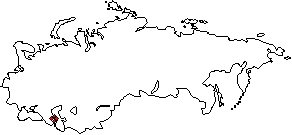CONTENTS
IntroductionForeword
Language Groups
Tribes and Dialects
Order the book
The Peoples
of the Red Book
Abazians (Abaza)Abkhaz
Aguls
Akhvakhs
Aleuts
Altaics
Aliutors
Andis
Archis
Asiatic Eskimos
Bagulals
Baraba Tatars
Bartangs
Bats
Bezhtas
Botlikhs
Budukhs
Central Asian Jews
Chamalals
Chukchis
Chulym Tatars
Crimean Jews
Crimean Tatars
Didos
Dolgans
Enets
Evens
Evenks
Georgian Jews
Godoberis
Hinukhs
Hunzibs
Ingrians
Ishkashmis
Itelmens
Izhorians
Kamas
Karaims
Karatas
Karelians
Kereks
Kets
Khakass
Khants
Khinalugs
Khufis
Khvarshis
Kola Lapps
Koryaks
Kryz
Kurds
Lithuanian Tatars
Livonians
Mansis
Mountain Jews
Nanais
Negidals
Nenets
Nganasans
Nivkhs
Nogays
Orochis
Oroks
Oroshoris
Peoples of the Pamirs
Roshanis
Rutuls
Selkups
Shors
Shughnis
Tabasarans
Talysh
Tats (Tatians)
Tindis
Tofalars
Trukhmens (Turkhmens)
Tsakhurs
Udeghes
Udis
Ulchis
Veps
Votes
Wakhs
Yaghnabis
Yazgulamis
Yukaghirs
visit the guestbook or mail comments to the webmaster

THE TATS
Habitat. The Tats live in Transcaucasia, in the districts of Siazan, Divichin, Kuba, Konakhkent, Shemakha and Ismaillin, in the city of Baku and on the peninsula of Apsheron, all mainly in the northeast of Azerbaijan. Settlements are not ethnically isolated and Tats live mixed with Azerbaijanis. The majority of the Tati people live in Iran, south of Teheran and dispersed in isolated northern villages.
Population. The census of 1926, records 28,433 Tats in Azerbaijan. Together with the Mountain Jews, the number of Tati-speakers was nearly 70,000.
| native speakers | ||
| 1959 | 11,500 | |
| 1979 | 22,441 | (native speakers 67.4 %), 8,800 in Azerbaijan and 7,400 in Dagestan |
| 1983 | ab. 25,000 |
Nearly 300,000 Tats, or 92.3 % of the whole nation, live in Iran.
The Tati language belongs to the Iranian group of the Indo-European languages. In Azerbaijan, the Tats are actually bilingual speaking Azerbaijani as a second language.
Religion divides the Tats into three groups: 1) Islamic (Shiites, the majority); 2) Christians (of the Armenian-Gregorian church, 3 settlements), and 3) Judaists, who are also called Mountain Jews and often treated as a separate people (see, Mountain Jews).
Origin and history. The origin of the Tats is obscure and literary references are scarce. They have been supposed as being aboriginal inhabitants of the Caucasus, who gradually, linguistically, iranicized, but later, in the process of the forming of the Azerbaijani people, did not turn Turkic. The complexities of their ethnic history are reflected in the fact that among Tati speakers there are Muslims, Christians and Judaists.
It is thought that Iranian-speaking inhabitants appeared in one-time Albania, the present Azerbaijan, some time in the 3rd or 4th century, when the dynasty of Persian Sassanids conquered the region. To secure the lands, the Persians settled them with Iranian-speaking people who gradually assimilated the ancient local population who maintained their language and gained the name Tats. The majority of them later adopted Islam.
According to statements by Azerbaijani ethnographers, the national culture of Islamic Tats, who are the people officially referred to as Tats, is almost identical to that of the Azerbaijani people. The only difference is the language.
Agriculture has been the traditional livelihood of the Tats. Their mountainous region with its mild climate is excellently suited for land cultivation, particularly fruit and grape growing. Livestock breeding is of less importance. Handicrafts are well developed. Tati carpetweavers and coppersmiths were, and still are, renowned. The occupations of the Tats of the Apsheron Peninsula developed in a somewhat different direction. As early as the 19th century, there existed a notable oil industry that employed, among others, many Tats.
In socialist Azerbaijan, the life of the Tats was greatly altered by the introduction of the Soviet regime and collectivization. However, this did not essentially change the means of subsistence for the Tats since the farmers still made their living from fruits and wine. Great changes have taken place in styles of architecture, and the Tats of the Apsheron Peninsula, because of their proximity to the city of Baku and its industrial areas, have culturally been particularly reform-minded.
The Tats of Azerbaijan have no written language of their own. Schooling is conducted in the Azerbaijani language. The only sphere of native culture is an oral folklore.
The assimilation of the Tats by the Azerbaijani has been an on-going process for centuries. It is greatly assisted by the common Islamic religion. The process was accelerated in recent years, however, when the covert but purposeful assimilation of all minorities living on the territory of the republic became the aim and policy of the Azerbaijani SSR. This is illustrated, for example, by the constant stressing of a common history and closeness of culture (even in academic publications). The situation that has developed around the Armenians in the Nagorno-Karabakh region serves as a warning. It should be noted, however, that the Tats living in Iran have not fared much better. The Iranians have also adopted an official policy of forming a unitary nation. The Tats in Iran are believed to have been almost fully culturally assimilated.
REFERENCES
- Г. А. Гулиев, Таты. -- Народы Кавказа. Т. II, Москва 1962
- Б. В. Миллер, Татские тексты. -- Иранские языки. Т. 1, Москва -- Ленинград 1945
- В. В. Миллер, Таты, их расселение и говоры, Баку 1929
IT